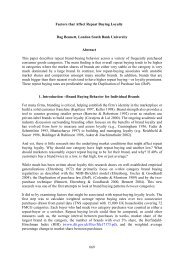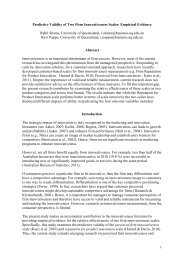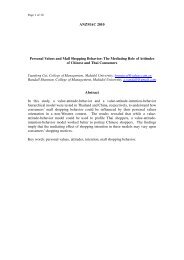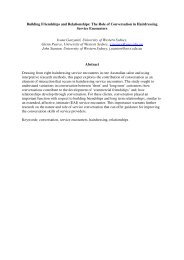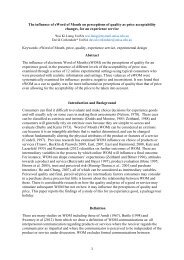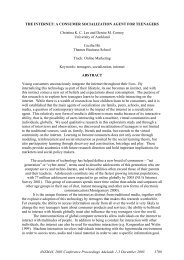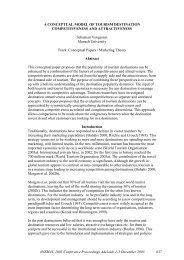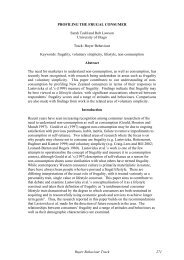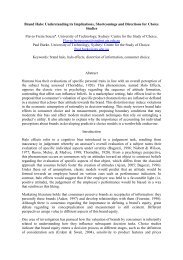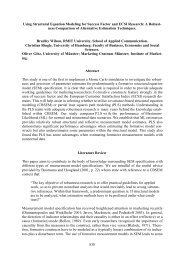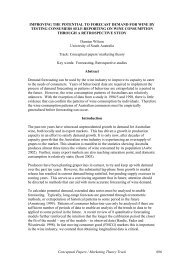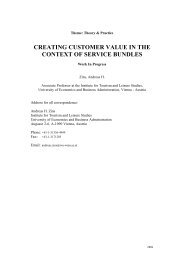Interviewing Young Children: a New Interactive Method - ANZMAC
Interviewing Young Children: a New Interactive Method - ANZMAC
Interviewing Young Children: a New Interactive Method - ANZMAC
Create successful ePaper yourself
Turn your PDF publications into a flip-book with our unique Google optimized e-Paper software.
question like “what do you think about this brand?” Or “what imagery do you associate with<br />
brand X?”, the adult interpretation of that is that they do not know exactly what they want<br />
and do not process information easily. Nothing could be farther from the truth.<br />
The most currently method used by researchers concerning young targets is the smiling faces<br />
scales, as they attract children’s attention. By the way, in order to answer with a smile,<br />
children should first understand the question and this will require an adult’s participation. An<br />
interesting approach conducted by Wyckham and Collins-Dodd (1997), asked children to<br />
match brands with products by using cards. <strong>Young</strong> children (from 3 to 6 years old) where<br />
able to choose the images that should go together and showed that they could easily<br />
recognize brands and logos. This experience also showed that children that could not<br />
identify a brand when it was plain script, matched the cards with the real brand very easily.<br />
A defining characteristic of children now a day is that they are highly visual. When facing a<br />
questionnaire, they go directly to the questions with graphs and charts or other visuals,<br />
instead of going through each question as they did before. Based on that fact, Kuhn and<br />
Eischen (1997) recommend researchers to present children with visual-based concepts rather<br />
than verbal statements. This provides children with a framework that they can process and<br />
through which they begin to provide feedback.<br />
According to McNeal and Ji (2003), visual impact matters more with children as they are an<br />
important audience for brand marketers, because not only are they strong influencers and<br />
future purchasers. One important observation is the fact that children pay attention to what is<br />
of interest for them and exclude all the rest. Visual imagery completely dominates the<br />
children recording of memories. <strong>Children</strong> seem to recognize brands and at some visceral<br />
level, understand their purpose. The image supports an emotional relationship for the<br />
children because they are physical and psychological representations that carry a lot of<br />
emotion. The physical representation will bring a meaning to the child whereas the<br />
psychological representation will bring pleasure (Montigneaux, 2002). The more the child<br />
will identify his/herself to the image, the more he/she will appreciate it and more pleasant<br />
this relationship will be.<br />
Acuff (2000) evokes the implication in packaging, for example, children of this age won’t<br />
pay much or any attention to verbal messages. Visual detail will be far more important as<br />
their brain is likely to focus on a predominant interesting and involving stimulus, as visual<br />
one. Images are more likely to grab their attention that verbal stimuli. Finally, Kline (2003)<br />
underlines that digital games are interactive media because they represent an emancipatory<br />
improvement over traditional one-way media and passive audiences. This one is also one of<br />
the reasons for which we designed the method presented in this paper.<br />
Objectives<br />
The main goal of the present paper is to provide a contribution to the development of<br />
appropriate research methodology addressing young targets. The purpose of the research here<br />
presented was to pre-test a method that could allow children from 3 to 8 years old to<br />
autonomously participate in an interview. The chosen subject was testing children’s toy<br />
preferences in a variety of situations.<br />
693



